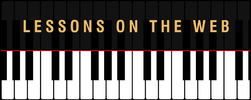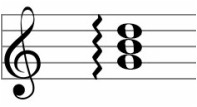|
Have you ever watched a young toddler take their first steps? First they're up on their feet, then a little wobbling...then one foot sort of moves forward...a little more wobbling...then the other foot comes forward...wobble...usually a giggle or two...then repeat. Before long, more steps are being taken with ease and much less wobbling and the next thing that happens is that you have a very happy toddler running (literally) around ...everywhere. They don't give a second thought to walking or running; they just do it as if they had done it since birth. It's a bit like this with getting our fingers to move faster on the piano!
After we get these things learned, we then move on to learning easy pieces and technical exercises that help to reinforce what we've learned. Part of growing as a piano player is being able to play music at faster tempos and being comfortable moving around on the keyboard at any tempo, with ease. While there are several ways to increase our finger speed, one of the best ways is by learning and practicing Arpeggios. Chances are...you've already played arpeggios and didn't realize it! To understand what an arpeggio is, let's go back and look at what a chord is. A chord, is any combination of 2 or more notes that are played at the same time. This is an example of a chord in the key of C major. You play this chord by playing all of the 4 notes at the same time, pressing your fingers down simultaneously. The notes are C, E, G, and C. It's important to remember that practicing chords definitely strengthens our hands and fingers a lot, and also gets our hands used to spreading out a bit over the entire keyboard. OK, so let's break that chord down into single notes now. If you were to play this chord as an arpeggio, it would look like this in your music. You are playing exactly the same notes, but the big difference is that you are playing them one at a time, right after the other one, instead of playing them all at the same time. That...is what an arpeggio is. It is a chord, broken down into single notes that are played one at a time in succession. Easy, right? Now you might recognize times when you've played arpeggios in your pieces or exercises, that you didn't realize what you were actually playing. This is how arpeggios are noted in music. Even though this is a different chord, you can see the squiggly line to the left of the chord. Anytime you see this in your music, you'll know to play that chord as an arpeggio, or one note at a time. Here's one more example. So How Can Practicing Arpeggios Help My Fingers Fly? There's something actually more technically challenging to playing arpeggios rather than chords, and it is the fact that you are having to play the notes separately. This requires a certain type of finger dexterity in order to play the notes evenly, in tempo, and correctly. The benefits are many and all of them make our fingers stronger and play faster.
Ready to Start Practicing Some Arpeggios? Here's How.
Before long, you will have learned all of the arpeggios! There's one more thing you can do at this point to increase your finger speed and dexterity. At this point, you want to start playing your arpeggios that you've now learned, faster and faster. This is when you want to get out your magic metronome and start practicing arpeggios with the metronome, slowly increasing your speed each day or week. Increasing the speed in which you play your arpeggios is one of the surest and best ways to successfully get your fingers moving faster and faster, all while playing the right notes! It's just like being a bit of a toddler again.
If you would like to learn more about Arpeggios, take a look at one of my latest videos on this topic with some live examples of how to play them! |
AuthorMost blogs written by Archives
June 2020
Categories
All
|






 RSS Feed
RSS Feed